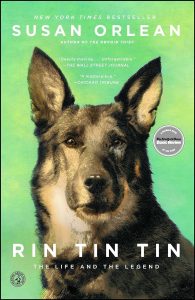In which I finish reading Rin Tin Tin
Last Sunday I sat down and finished the last sixty pages of Susan Orlean’s Rin Tin Tin: The Life and the Legend. I had been reading it on and off over the last six months in small bites. Sometimes I put it aside because another book called my name. For one reason or another. (The Girls of Atomic City, for instance.) But often I put it aside because it was so intense that I needed a little break.
The intensity took me by surprise. I have no emotional attachment to Rin Tin Tin as a cultural icon. I am not old enough to have seen the The Adventures of Rin Tin Tin when it ran in prime time and have no memory of watching it in reruns on Saturday mornings. (On the other hand, I have fond memories of seeing an occasional episode of Sky King.) I finally pulled the book off my shelf, where it had sat unread for a decade, because My Own True Love and I were watching The Thin Man movies and he wondered which dog appeared in the movies first, Rin Tin Tin, Lassie, or Asta.*
Rin Tin Tin is alternately heartwarming and heartbreaking. Orleans begins with the story of a man’s love for a dog that he rescued from the battlefields in World War I. The book then moves through the world’s love first for films and then television programs that initially starred and later featured characters based on the original Rin Tin Tin. It ends with a handful of people who were obsessed with Rin Tin Tin, both as an animal and as an intellectual property, including legal battles over control of the dog’s name, image, and descendants.
Orleans sets the Rin Tin Tin story against a rich backdrop of related stories, including:
- The development of German Shepherds as a working breed by by a German cavalry officer named Max von Stephanitz using various traditional German herding dogs in the early twentieth century.
- The changing use of dogs in film and television.
- The shift of dogs from outdoor working animals to pets, and the related growth of kennel clubs and obedience training.
- The Nazi idolization of German Shepherds as pure-bred “Aryan” dogs—and Hitler’s relationship with his own dogs.
- The recruitment of dogs for the United States Army’s K-9 Corps in World War II. (This was one of the points at which I had to set the book down for a while. I had learned about the K-9 corps previously when we visited historical Fort Robinson in Nebraska. Orleans looks at the story in more depth, which made it even more distressing as far as I was concerned.)
- Why Westerns were so popular after World War II
As is often the case with Orleans books, she includes her experience of reporting the story, bringing the reader through the process.
In short, Rin Tin Tin is a masterful piece of storytelling.
*Rin Tin Tin by a long shot. He first appeared in silent movies, beginning in 1922. Also, as Orleans points out, Rin Tin Tin was a real dog who played fictional characters. Lassie and Asta were fictional characters in novels adapted for film. Not the same thing at all.





